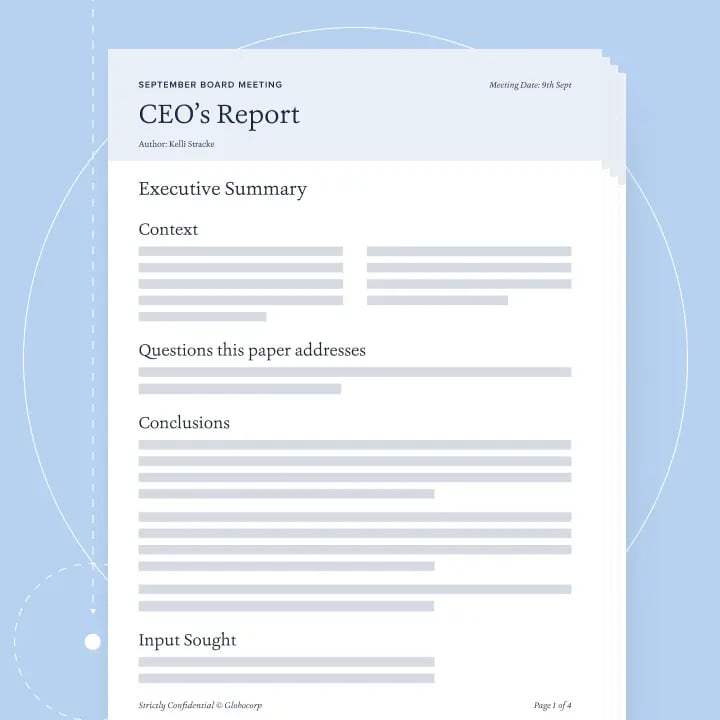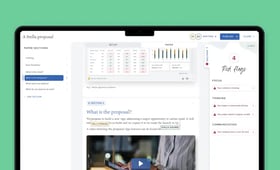A board governance framework is like an instruction manual for a board of directors. It lays out how the board should operate, make decisions, and hold itself to account. It defines the rules, roles, and processes that ensure a board works efficiently and effectively.
What is the purpose of a board governance framework?
Boards exist to steer and to supervise — they guide strategy, make key decisions, and manage risk for sustainable value creation. Without a clear framework, discussions can veer off-course, responsibilities can blur, and good governance and compliance can fall through the cracks.
A governance framework brings structure and consistency so that every director knows what’s expected of them, how to prepare, and where to find the information and guidance they need. When these processes are clearly defined and understood, directors arrive at meetings well-prepared, aligned, and primed to add value. This helps board discussions to run efficiently, ensures board decisions stand up to scrutiny, and helps the board to shift from firefighting to forward-looking oversight.
What are the core components of a board governance framework?
Board governance frameworks are typically built around five pillars:
- Board and committee structure and composition: who sits on the board and its committees, committee remits, reporting lines, and escalation paths.
- Roles and responsibilities: the roles and remit of non-executive directors vs. executive directors for boards and committees.
- Policies and procedures: conflict-of-interest protocols, codes of conduct, delegation of authority, which decisions require full-board sign-off vs. committee or executive approval, voting thresholds, and board review procedures.
- Risk and control: risk appetite parameters, risk reporting and management processes, internal controls for preventive, detective, and corrective measures.
- Stakeholder engagement: expectations for communication with shareholders, regulators, employees and other stakeholders.
In the UK and the US, the board of directors is ultimately accountable for the company’s governance. It must set the governance framework and high-level policies, define board and committee roles, and ensure compliance with statutory duties and applicable governance codes, while delegating implementation to management and committees as appropriate.
Practices vary in other markets. Some jurisdictions, notably the UAE and Saudi Arabia, have introduced formal governance codes and strong regulatory oversight. In others, where there is widespread family- or state-ownership and control, differing company law and uneven enforcement often mean boards have less independence and accountability when it comes to setting governance frameworks.
Board structure and composition
A board is generally comprised of a chairperson, executive directors (with the CEO The structure of a typical board varies by jurisdiction.
A typical UK or US board includes three categories of members: the chair, executive directors (for example, the CEO and CFO), and non-executive directors (NEDs) or outside/independent directors.
To ensure focused oversight, boards delegate detailed work to specialist committees (for example, audit, risk, nomination, and remuneration) that report back with recommendations. Committees should have clear terms of reference to avoid overlaps and manage conflicts of interest. For example, an audit committee oversees financial reporting, whereas the risk committee focuses on emerging or strategic risks. A nomination committee handles board appointments and succession. By splitting these responsibilities, each group can probe issues in depth and advise the main board confidently.
The UK Corporate Governance Code recommends that at least half of the board should be independent directors — ideally with diverse backgrounds. The Code further states that the board should ensure a range of experience, skills, knowledge, and professional qualifications when considering the composition of the board committees.
Roles and responsibilities
The board governance framework lays out the roles and responsibilities of board members. These are set out in a mandate approved by the board. It will clearly separate duties and responsibilities between all board members.
As a general guideline, these are the chief roles and responsibilities of key board members:
- Chair: The chairperson leads the board and is responsible for setting the agenda, leading the meeting, and ensuring the board functions independently from management.
- Executive directors: The executive directors are responsible for the company's day-to-day operations. They make key operational decisions, implement board-approved strategies, and report on performance.
- Independent/outside/non-executive directors: provide independent oversight and support the chair and executive team.
- Standing or board committees: specialised groups that focus on specific areas (finance, audit, risk, etc.) and provide in-depth analysis and make recommendations on behalf of the board.
- Governance team: The lead governance professional (called a company secretary in the UK or a board secretary in the US) helps ensure compliance with legal and regulatory requirements, facilitates board meetings, maintains records and advises on governance practices.
How do you build your board governance framework?
Building a board governance framework requires careful consideration of board structure, roles, policies and performance evaluation. The steps are:
- Define the board’s structure, composition, and members’ roles and responsibilities.
- Establish key committees that are relevant to your company or industry.
- Develop clear board governance policies, including a code of conduct and risk management framework.
- Implement a board evaluation process, which may include independent reviews.
- Establish mechanisms for stakeholder engagement and transparent communication.
- Ensure the framework aligns with legal and regulatory requirements.
There are a range of software tools that can help to manage this process. For example, board management software can securely manage meeting agendas, organise board and management papers, prepare meeting minutes, and enable e-signatures for approvals and resolutions. Governance, risk and compliance software can automate compliance tracking and regulatory reporting, evaluate board effectiveness, and report internal audit findings.
Policy development and implementation
Policies guide board conduct, decision-making processes, risk management, and compliance with legal and regulatory requirements. These may include creating a Code of Conduct, setting Conflict of Interest guidelines, and establishing rules around performance evaluation and executive compensation.
Once developed, use your board portal tools to implement and review policies to ensure they remain relevant and aligned with evolving governance best practices and regulatory changes.
Decision-making processes
The board governance framework will establish clear guidelines for making decisions. It starts by outlining the different types of decisions and the appropriate delegation levels and processes for each.
A simple matrix to facilitate decision-making is the “who, how, when, where, and why” of decisions:
- Who: the entity that will make the decisions (full board or executive committee, etc.)
- How: the voting process; this must be clarified for each type of decision
- When: when the board's decision is to be made
- Where: the place where the decision is to be made
- Why: the reasons board members make their decisions (for example, the criteria directors are asked to consider)
Strategic decisions like mergers, partnerships, and investments would be made at board level. Executive management will make operational decisions and include hiring or firing senior executives, budget allocations, and compliance and regulatory matters. Finally, committee-level decisions include CEO performance and remuneration, board member succession planning, and risk management and financial reporting.
Board portal software can help facilitate decision-making through secure document sharing, e-signatures, voting mechanisms and stakeholder engagement tools.
Board reporting software can help provide board members with high-quality information when making decisions – for example, ensuring certain questions, stakeholder groups, and options are considered by management in their decision papers and by the board in their discussions.

A thinking and writing platform that helps you to write brilliantly clever and beautiful reports that surface breakthrough insights and spur your business to action.
Find out moreRisk and control mechanisms
The board is responsible for an organisation’s approach to risk management and internal control. Here, the audit committee, acting independently from the executive, will ensure that the interests of shareholders are adequately protected in relation to internal control and financial reporting.
The board will exercise its governance responsibilities by understanding the risks to organisational objectives and the controls management has put in place to mitigate those risks.
Risk management integration
Risk management integration involves embedding risk assessment, monitoring, and mitigation strategies into the board's decision-making processes and overall corporate governance. It entails determining the nature and extent of the principal risks and the risks the organisation is willing to take to achieve its strategic objectives.
Internal control systems
Internal control systems enhance decision-making by providing real-time insights into company performance while reducing financial risks. They also improve stakeholder confidence by ensuring compliance with governance standards and increase operational efficiency by streamlining processes and eliminating redundancies.
Internal control systems are generally preventive (preventing errors before they occur), detective (identifying errors after they occur), and corrective (rectifying issues uncovered by the detective controls). A recent study, Corporate Governance and Internal Control Mechanisms: Developing a Strategic Framework, proposed five pillars of internal control systems that are essential for effective corporate governance. These are:
- Risk assessment
- Control activities
- Information
- Communication
- Monitoring
The board could also use a recognised framework or standard (e.g., COSO, ISO, COBIT, etc.) as part of its process for designing and maintaining the effectiveness of the internal control framework.
Stakeholder management
Communication channels
When making decisions that impact your stakeholders, engaging early and frequently is imperative. Giving stakeholders context around decisions is essential for building trust and pre-empting potential misunderstandings.
As the UK Corporate Governance Code says, “Dialogue with stakeholders can help boards understand significant changes in the landscape, predict future developments and trends, and re-align strategy.”
Ensure they’re regularly informed about the company’s strategies and decisions through annual reports, press releases, shareholder meetings, open forums, and direct engagement. Communication with stakeholders – as with any group – has to be honest, timely, easy to engage with, and consistent. Read our top tips for effective business communication to find out how to do this in practice.
Accountability measures
Accountability mechanisms such as independent audits, governance committees, and ethical guidelines uphold trust and demonstrate responsible decision-making. And because scaling up is what software excels at, you can use technology to ensure adoption throughout the business. Platforms like Board Intelligence can give you easy-to-use, automated tools for internal reporting and to assign and track board members’ responsibilities towards various stakeholders.
Framework review and evolution
A board governance framework must not be static; instead, it should be regularly reviewed and evolved to meet changing business needs, regulatory requirements, and stakeholder expectations.
A holistic framework review will assess how authority is exercised and controlled in an organisation by delving into the roles of the board, committees, and senior management. The process includes a review of relevant governance documentation, online surveying of key stakeholders, interviews with the board and leadership team, and the development of draft recommendations for changes and improvements.
Board Intelligence’s Board Surveys tool can be used to facilitate such activities.
Performance monitoring
Performance monitoring requires a structured approach to ensure board effectiveness, compliance, and accountability. Key methods include:
- Regular board reviews.
- Internal and external compliance audits.
- Tracking key governance metrics.
- Gathering insights from shareholders, employees, and other key stakeholders.
- Risk and internal control assessments.
- Benchmarking against best practices.
- Using board portal software to streamline governance reporting, track compliance, and measure board engagement and performance over time.
Continuous improvement strategies
Effective board governance frameworks act as an enabler of organisational performance, rather than a handbrake. They should therefore be aligned with, and supportive of, the organisation’s innovation culture to ensure the business can take advantage of new opportunities and navigate the risks and challenges ahead.
Boards can implement improvement strategies by regularly reviewing policies, engaging in timely, relevant board development, and staying current on board governance best practices.
FAQs
How does a board governance framework differ between public and private companies?
It differs due to variations in regulatory requirements, stakeholder expectations, levels of external scrutiny, and governance structures. For example, public companies must comply with various government codes, whereas private companies often have more flexibility with fewer reporting and compliance obligations.
What are the key challenges in implementing a new board governance framework?
Key challenges include board members' resistance to change, aligning internal stakeholders, and the training required to understand the new framework. Ensuring the new framework is compliant with regulations and codes can also be complex and time-consuming.
How often should organisations review and update their board governance framework documentation?
Organisations should review their board governance framework documentation at least annually. If there are regulatory or legislative changes, significant organisational changes (for example, a merger), corporate risk incidents, and technological advancements, it would be considered good practice to review it more frequently. The emergence of AI, for example, has prompted many organisations to review their board governance frameworks to ensure their governance structures, processes, and practices are sufficiently agile and resilient.



